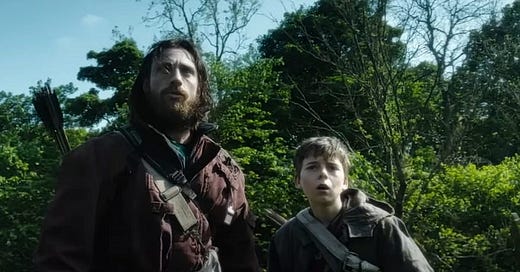Film Review - 28 Years Later
Danny Boyle is back for another gnarly, politically charged instalment of zombie, sorry, “infected”, mayhem
Don’t call them zombies, because Danny Boyle says they aren’t. They’re the “infected”. Infected by what? The “rage virus”. What’s that? You didn’t see Danny Boyle’s 28 Days Later (2002) or its non-Boyle-helmed sequel, 28 Weeks Later (2007)? Never mind. You can jump in here just as easily as this much-belated sequel, 28 Years Later, stands in its own right. At least, it does until we reach the obvious sequel teaser in the closing scene.
The rage virus is deftly demonstrated by a tense and gruesome prologue involving a group of young children watching Teletubbies. This sequence has already been teased in a trailer that, for once, doesn’t give away too much. I’ll try to follow that example by not discussing the plot in detail, except to say the action then flashes forward 28 years (hence the title) to Holy Island, off the Northumbrian coast. Here, a human community survives, cut off from mainland Britain except by a causeway accessible only in low tide. Incidentally, Britain has been placed under quarantine from the rest of the world (which seems to have recovered from the rage virus).
In this environment, we meet twelve-year-old Spike (Alfie Williams), his father, Jamie (Aaron Taylor-Johnson), and his mother, Isla (Jodie Comer), who is sick with a mysterious illness. Jamie takes Spike to the mainland on a manly rite-of-passage, where the islanders occasionally forage for supplies. Here, they encounter the “infected”, both fast and slow variants, as well as a new, deadly version called “Alphas” that are bigger and tougher to kill. These days, they run around naked too, but with lots of mud and grime on their bodies. Presumably, so there aren’t too many penises to upset American audiences.
Boyle intercuts some of the action with images from Henry V (1944), footage of British soldiers off to war, and various other archival snippets, all set to Rudyard Kipling’s poem, “Boots”. The Brexit allegory is immediate and obvious. It’s also clear Boyle and screenwriter Alex Garland are targeting “Little Englander” mindsets that yearn for the good old days of British imperialism. If you’ll forgive my use of an obscenity, it’s also possible they have so-called “toxic masculinity” in their crosshairs. But whatever their allegorical intentions, 28 Years Later rattles along at an entertaining pace, piling on the blood, guts, and suspense.
It’s difficult to say much more without getting into spoiler territory, but at least one major aspect of the plot feels like a political statement concerning recent UK legislation. Another major actor turns up in the film (I won’t reveal the actor or the role he plays, although the trailer does). As for the aforementioned finale, it’s bound to set tongues wagging as to where the sequel might head. On a different note, this is another horror film I’m surprised got away with the less restrictive 15 certificate in the UK, rather than an 18 certificate (it is R-rated in the US).
There are some deftly atmospheric touches that I appreciated, being largely familiar with the territory in question. For instance, the inclusion of the Angel of the North. One tense scene plays out against starry backdrops with glimmers of the Northern Lights. Another memorably menacing shot features an Alpha silhouetted on a distant hilltop against a sunset. I should add the inclusion of the famous Hadrian’s Wall sycamore tree makes clear we’re in a parallel universe (for non-UK readers, the tree in question was recently felled by vandals, to nationwide fury). Cinematographer Anthony Dod Mantle deserves a special nod for all this vivid imagery.
I must confess I had hoped for a slightly different ending, though I won’t explain what, for obvious spoiler reasons. However, if sequels ensue, the plot idea in question may well come to fruition in any case. Such quibbles aside, 28 Years Later is directed with all the slickness and style we’ve come to expect from Boyle, edited by regular collaborator Jon Harris with pacy, near pop-video efficiency. It will doubtless be a must for horror aficionados, and general audiences should also enjoy it, provided they aren’t too squeamish about the gore.
(Originally published at Medium.)
The Dillon Empire beyond Substack
For a full list of my published novels, click click here.
For more on my novels and other fiction projects, click here.
For my Patreon page, click here.
For my Medium page, click here.






Watched it last night with my Letterboxin’ daughter; she gave it four and I gave it a ‘meh’ three and a half stars. But we both agree that the second film is probably the best of the three so far.
Been her before, and it was better first time around. Cillian Murphy made more of an impression in the first than Aaron Taylor-Johnson does here, and Jodie Comer was wasted. On the plus side, Alfie Williams is terrific, and Ralph Fiennes is his now usual reliably brilliant self (incredible to think how much better he is now than he was in his earlier career, eg the execrable Saint…), if not a bit weird…ha-ha!
And, yes, sequels aplenty appear lined up and waiting…
PS The Brexit allegory was like being hit over the head by a sledgehammer; I’d have preferred a more subtle approach, but I confess that where Brexit is concerned, sledgehammers are probably the weapon of choice with which to beat some sense into the brain dead ‘infected’…